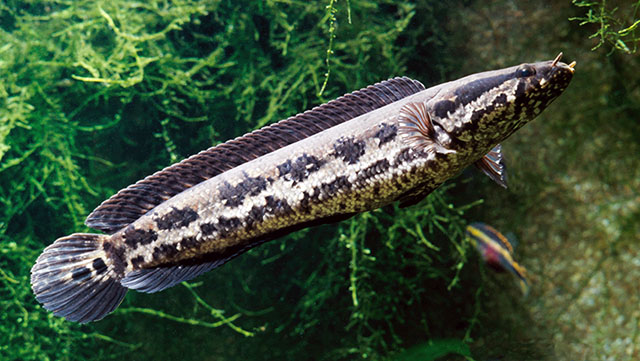| Channidae (Snakeheads) |
| 50 cm SL (male/unsexed); max.weight: 1,000.0 g |
|
demersal; freshwater, potamodromous |
| Africa: widely distributed from the Senegal River to the Chad system (Ref. 3575, 57290), including the Volta and Niger basins and many coastal basins in West Africa (Ref. 57290), up to the Nile (Ref. 3575, 28714) and Congo basins (Ref. 45434, 106290, 111328). In Lower Guinea known from most coastal basins (Ref. 81648). |
|
Dorsal spines (total): -0; Dorsal soft rays (total): 39-45; Anal spines: -0; Anal soft rays: 26-32. Diagnosis: body elongate; lateral-line scales medium-sized, numbering 65-78; head depressed anteriorly, relatively long and covered with scales larger than those on body; lower jaw slightly longer than the upper, with 4-6 well developed canines; dorsal and anal fins not touching caudal fin; dorsal fin with 39-45, anal with 26-32 rays; 5-8 more or less rounded or polygonal dark blotches on flanks (Ref. 57290, 81648, 11328). 19-24 scales in transversal series (Ref. 11328).
Description: eyes lateral, relatively large; lateral line usually complete, occasionally discontinuous (Ref. 11328).
Coloration: life specimens blackish to very dark olivaceous, marbled with ochre ventrally (Ref. 57290, 81648, 11328), preserved specimens with a light gray to dark gray body, darker on head and dorsally, marbled with white ventrally (Ref. 11328). 5-8 more or less rounded or polygonal dark blotches on flanks; dark lateral band on head, broadening between hind margin of eye and hind margin of gill cover; fins with more or less distinct dark spots/maculae forming oblique bands; small, rounded black spot at base of caudal fin; fingerlings (prejuveniles) ochre-coloured, with a black band running along middle of sides, from tip of snout to hind margin of caudal fin (Ref. 57290, 81648, 11328). Dorsally, on each side of the dorsal fin, some dark spots are apparent, tending to link together to those of the flanks (Ref. 11328). |
| Inhabits marginal vegetation and floodplains. Feeds on insects and small fish (Ref. 28714). Maximum SL reported 50.0 cm (Ref. 31256) larger than maximum TL 45.5 cm (Ref. 81648). |
|
Least Concern (LC); Date assessed: 21 April 2019 Ref. (130435)
|
| harmless |
Source and more info: www.fishbase.org. For personal, classroom, and other internal use only. Not for publication.

